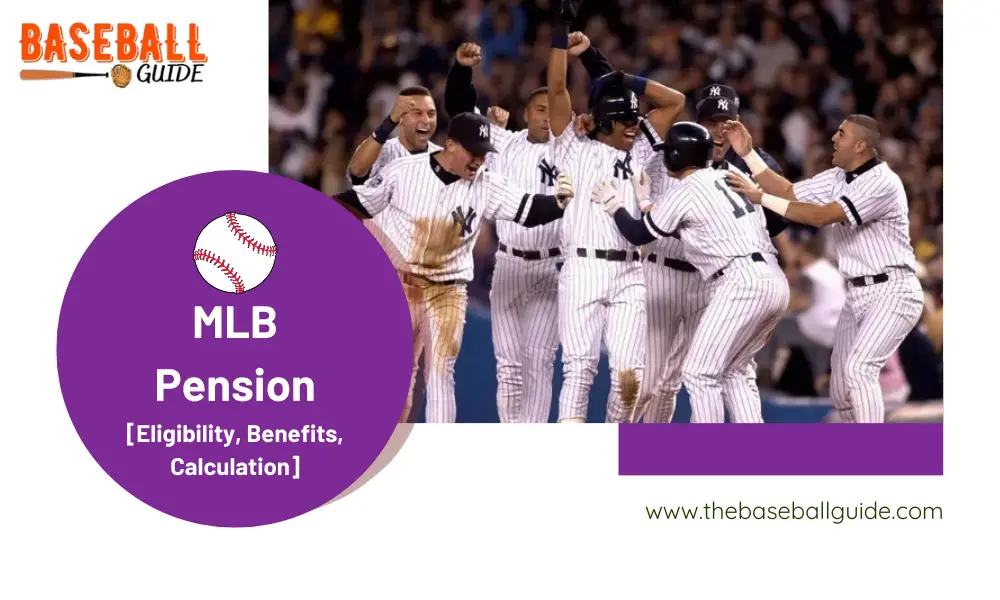When we think of baseball, we often picture the excitement of the game itself but what happens after the final pitch is thrown?
Major League Baseball (MLB) is one of the most popular professional sports in North America. Fans from all over the world come to watch their favorite teams compete.
However, few people know about the retirement benefits available to MLB players.
Is it new to you, or you already knew it?
In this blog post, we will discuss the MLB pension program, its eligibility requirements, the types of benefits offered, how it is calculated, examples of former players who have benefited from it, taxation of the pension, and how it has changed over time.
Phew! Let’s start!

Do MLB Players Get a Pension?
Yes, MLB players do get a pension. The pension program was first introduced in 1947 and has been updated several times since then. The current pension program is offered through the Major League Baseball Players Association (MLBPA), which is the players’ union. The pension program is available to all eligible players who have played at least one game in the major leagues.

Eligibility Requirements for MLB Pension
To be eligible for the MLB pension, players must have played at least one game in the major leagues. Additionally, players must have at least 43 days of service in the major leagues to be eligible for a pension benefit.
However, players who retired before 1980 are subject to different eligibility requirements. They must have played at least one game in the major leagues and have four years of service in the minor leagues or a combination of minor and major league service.
Types of Benefits Offered Through MLB Pension
The MLB pension program offers several types of benefits, including a regular pension, a disability pension, and a pre-1980 pension. The regular pension is available to players who have at least 43 days of service in the major leagues.
The amount of the pension benefit is based on the player’s years of service in the major leagues. For example, a player who played for 10 years in the major leagues can receive a pension of up to $220,000 per year.
The disability pension is available to players who are unable to play due to an injury or illness. The disability pension benefit is calculated based on the player’s years of service in the major leagues and their average annual salary.
The pre-1980 pension is available to players who retired before 1980 and have at least four years of service in the minor leagues or a combination of minor and major league service.

How Is MLB Pension Calculated?
The amount of the MLB pension benefit is based on the player’s years of service in the major leagues.
The benefit is calculated using a formula that takes into account the player’s years of service and their average annual salary during their three highest-paid seasons.
The formula is complex, but it generally results in a higher pension benefit for players who played longer in the major leagues and had higher salaries.
Examples of Former Players Who Have Benefited from an MLB Pension
Several former players have benefited from the MLB pension program. One example is Dave Winfield, who played 22 seasons in the major leagues.
Winfield currently receives a pension of over $600,000 per year.
What’s your thought on this? Do let me know.
Taxation of MLB Pension
The MLB pension benefit is subject to federal income tax.
However, the amount of the pension benefit that is subject to tax depends on the player’s age at retirement and the amount of their benefit.
The MLBPA provides a tax calculator to help players estimate their tax liability.

How MLB Pension Has Changed Over Time
The MLB pension program has changed several times since it was first introduced in 1947.
One significant change occurred in 1980 when the eligibility requirements for players who retired before 1980 were updated.
Another change occurred in 2011 when the pension
benefits were increased for players who played before 1980.
In 2015, the pension benefit for players who played after 1980 also increased.
These changes were made to ensure that former players receive adequate retirement benefits.
Another change to the MLB pension program occurred in 2016 when the MLBPA negotiated a new collective bargaining agreement (CBA) with the league.
The new CBA included several changes to the pension program, including an increase in the minimum salary for major league players, an increase in the maximum pension benefit, and improvements to the disability pension benefit.

Conclusion
And with that, we come to the end of our exploration of the MLB Pension.
I hope this post has shed some light on an important aspect of baseball history and culture.
Whether you’re a current player, a retiree, or simply a fan of the game, the MLB Pension is a reminder that baseball is more than just a sport — it’s a community.
The MLB pension program is an important retirement benefit for former major league players. Eligible players can receive a regular pension, a disability pension, or a pre-1980 pension.
The pension benefit is based on the player’s years of service in the major leagues and their average annual salary during their three highest-paid seasons.
Former players such as Dave Winfield and Frank Robinson have benefited greatly from the program.
The program has undergone several changes over the years, and the MLBPA continues to negotiate improvements to ensure that former players receive adequate retirement benefits.
Here are some of our recent blogs: Dodgers Mascot, Little League Pitching Rules, Pony League Bat Rules, and NCAA Pitching Rules.

